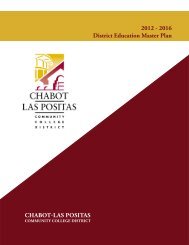City College of San Francisco - California Competes
City College of San Francisco - California Competes
City College of San Francisco - California Competes
Create successful ePaper yourself
Turn your PDF publications into a flip-book with our unique Google optimized e-Paper software.
STANDARD III.C<br />
II. Standard Report III.C: Technology Resources<br />
Technology resources are used to support<br />
student learning programs and services<br />
to improve institutional effectiveness.<br />
Technology planning is integrated with<br />
institutional planning.<br />
III.C.1. The institution assures that any technology<br />
support it provides is designed to meet the<br />
needs <strong>of</strong> learning, teaching, college-wide communications,<br />
research, and operational systems.<br />
III.C.1.a. Technology services, pr<strong>of</strong>essional<br />
support, facilities, hardware, and s<strong>of</strong>tware<br />
are designed to enhance the operation and<br />
effectiveness <strong>of</strong> the institution.<br />
The <strong>College</strong>’s technology responds to the needs<br />
<strong>of</strong> the institution. Following a period <strong>of</strong> scarce<br />
resources in the 1980s and early 1990s, the<br />
<strong>College</strong> laid careful plans identifying the most<br />
important project priorities for technology<br />
spending between 1996 and 2001, during which<br />
time two citizens’ bonds were approved, making<br />
available the substantial sum <strong>of</strong> $24 million for<br />
technology development. Enormous results from<br />
this investment have been realized, especially<br />
since the time <strong>of</strong> the last self-study team visit in<br />
the year 2000, leading the technology committee<br />
to report that technology has indeed enhanced<br />
institutional operations and effectiveness. This<br />
subsection highlights some <strong>of</strong> the ways in which<br />
technology has achieved substantial results and<br />
also suggests what remains to be accomplished.<br />
[Refs. 6, 7, 8, 21]<br />
The most important priority for investment has<br />
been the development <strong>of</strong> the college-wide network.<br />
Until this project was undertaken, CCSF<br />
had a mainframe-based network with terminals<br />
and stand-alone computers, each with different<br />
operating systems and applications. The database<br />
system had previously been hosted remotely<br />
and required dumb terminals, until finally the<br />
<strong>College</strong> invested in a new database system for<br />
mission-critical applications such as student<br />
records, financial records, etc. However, even<br />
this new database system needed connectivity<br />
in order to be accessible and useful. Thus, the<br />
<strong>College</strong> began constructing a fiber optic network,<br />
wiring each building on the Ocean Avenue<br />
Campus as well as the remote campuses, floor<br />
by floor, room by room. Then the buildings<br />
themselves were connected on the Ocean<br />
Avenue Campus, pulling cable through underground<br />
conduits and into buildings, where<br />
wiring closets linked the campus electronically.<br />
However, the campuses were not connected,<br />
except by dial-up communications and T-1<br />
phone lines, so the <strong>College</strong> awarded a multi-million<br />
dollar contract to the <strong>City</strong>’s Department <strong>of</strong><br />
Telecommunications and Information Services<br />
to connect the campuses throughout the city<br />
using underground conduits along the rail<br />
transit lines, a project that is now more than<br />
50 percent complete. [Refs. 20, 21]<br />
Simultaneous to the construction <strong>of</strong> the network,<br />
the <strong>College</strong> began a major project called<br />
the “Desktop Rollout” project. New desktop<br />
computers were acquired and some <strong>of</strong> the existing<br />
later-model PCs were upgraded so that over<br />
2,500 employees—trained in the new s<strong>of</strong>tware<br />
and password security procedures—could work<br />
with standardized operating systems and applications,<br />
share documents and data, communicate<br />
with a fully functional email system, and have<br />
access to the <strong>College</strong>’s Banner database system.<br />
In addition to all <strong>of</strong> this, the 20-plus-year old<br />
expensive and outdated telephone system was<br />
replaced with a new system that operated not<br />
over the old copper wiring but rather over the<br />
new fiber optic network, using the technology<br />
called Voice over Internet Protocol (VoIP). These<br />
projects were huge undertakings, involving the<br />
planning and participation <strong>of</strong> pr<strong>of</strong>essional staff,<br />
contractors, and, most important, the cooperation<br />
<strong>of</strong> the many <strong>College</strong> users. [Ref. 12]<br />
CITY COLLEGE OF SAN FRANCISCO<br />
199







